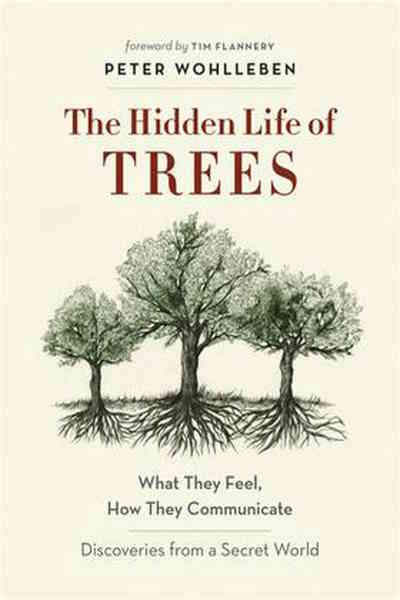The Hidden Life of Trees
Denver Kanowski reviews Peter Wohlleben’s 2015 book.
Peter Wohlleben has devoted his life to trees. He spent 20 years working in the Forestry Commission in Germany and then went on to run an environmentally friendly woodland in the Eifel mountains in Germany where he works towards the return of primeval forest.
This book records his observations over many years and gives an expanded view on life on the planet beyond anthropocentricity.
Forests, explains Wohlleben, are social networks where parents support, nurture, and communicate with their offspring, and even warn each other of imminent danger.
His experience is based on the forests of central Europe, and while there are differences from the Australian environment there are also many common observations.
He notes the lifespan of trees – one example is a spruce in Sweden that is 9,500 years old and still growing – that equates to about 115 consecutive human lives.
Electrical impulses through tree roots travel at about half an inch (12mm) per second.
Wohlleben talks about the ‘Wood Wide Web’, a soil fungus network that connects vegetation. Fungi are somewhere between animals and plants. Their cell walls are made of chitin (a substance never found in plants – more like insects). Fungi cannot photosynthesise and thus depend on organic connection. Mycelium are the root-like structures of fungi, underground cottony webs which can be quite extensive. One example given is the Honey Fungus in Switzerland which covers 120 acres and is estimated to be 1000 years old. Another example is in Oregon USA and is 2400 years old and covers in excess of 2000 acres. It weighs 660 tonnes.
Fungi are the largest living organisms on the planet.
When fungi enter the roots of trees, these trees are boosted in their levels of nitrogen and phosphorus. The fungi create a network between trees. The trees give sugar and carbohydrates, up to one third of their production. Experiments performed with radioactive isotopes have proven crossover of radioactive carbon – even between different species of trees. Beeches, Oaks, Fir, Spruce and Douglas Fir have been proven to interconnect in this way. (See the article in Nature from 1997.) They also filter heavy metals.
This ability to network between trees is evidenced by living tree roots (Beech Trees) where stumps have continued to live long after they have been cut down. Some of the readers will have seen this same phenomenon with Bunya Tree stumps in the Bunya Mountains. The stumps are being nourished by surrounding trees through the fungal network.
Wohlleben says:
A tree is not a forest. On its own a tree cannot establish a consistent local climate. It is at the mercy of wind and weather. But together, many trees create an eco-system that moderates extremes of heat and cold, stores a great deal of water, and generates a great deal of humidity.
During the recent drought I observed the death of a solitary Brigalow tree in the middle of a grass paddock – it presumably fell victim to the extremely dry conditions. For those who aren’t aware – Brigalow trees have a reputation for being pretty tough and will sucker freely into communities. I saw no other mortalities and the solitary tree should have had more than its share of moisture – yet it died. Having read Wohlleben’s story I wonder if I was observing the lack of support from other trees. From a human perspective, could it have died from loneliness?
Wohlleben observes that in plantations there isn’t usually any root networking. Perhaps this may develop with time as beneficial fungi are introduced?
Research has found that tree roots crackle at 220 hertz and are receptive to each other.
A few observations
- Douglas Fir trees – when one was struck by lightning another 10 were killed – apparently the electrical shock was transferred through their roots via the fungal network.
- Mimosa – sensitive plants – react when water droplets fall on them by closing their leaves. After a while they understand that this isn’t a danger and don’t react – even for weeks.
- It seems trees have brain-like structures at their root tips. When they are root pruned these structures are removed and when the tree is finally planted out the roots do not develop as nature would intend it and they become rather shallow rooted and more dependent on outside support to survive.
- Lichens – a symbiotic combination of algae and fungi which are slow-growing and non-harming – live for hundreds of years.
- The underside of leaves normally ‘breathe’ while the top sides photosynthesise.
- Conifer forests reduce the number of germs in the air by producing phytoncides which have antibiotic qualities. The environment thus created is healthy for people with allergies.
- Why do we see green colour emitted from trees? Chlorophyll has a green gap and cannot utilise this part of the light spectrum – it is reflected back unused. This reflected light has a positive effect on the human psyche.
- Deciduous trees evolved around 100 million years ago, conifers some 270 million years ago.
Viewpoints from around the world
Chief Marilyn Slett – President of the Coastal First Nations: ”Our leaders understand our well being is connected to the well being of our lands and waters. If we use our knowledge and our wisdom to look after them, they will look after us into the future.”
The Kickwa People of Sarayuku, Ecuador see their forest as the most exalted expression of Life itself.
The Constitution of Switzerland states: “account is to be taken of the dignity of creation when handling animals, plants, and other organisms.”
In New Zealand the Maori people have successfully brought the intrinsic rights of nature to the recognition of the legal system.
This book raises an interesting question: is humanity at the pinnacle of evolutionary perfection?
‘Red in tooth and claw’ is an attribute of the animal world. The plant kingdom may be more successful at harmoniously co-existing and nurturing not only each other, but all life forms, including the Earth’s environment. The concept of ‘Gaia’ – the Earth – as a living, breathing entity is ancient wisdom, and has been promoted by such respected people as James Lovelock, a noted scientist, and by the Dalai Lama.
Clearly if nature withdraws its favours then the animal world (including humans) cannot survive. It may be in the interest of future generations for humanity to learn humility and respect for all sentient beings. After reading this book it is clear to me that the plant world is included in these criteria.
Disclaimer: views represented in SOFiA articles are entirely the view of the respective authors and in no way represent an official SOFiA position. They are intended to stimulate thought, rather than present a final word on any topic.


